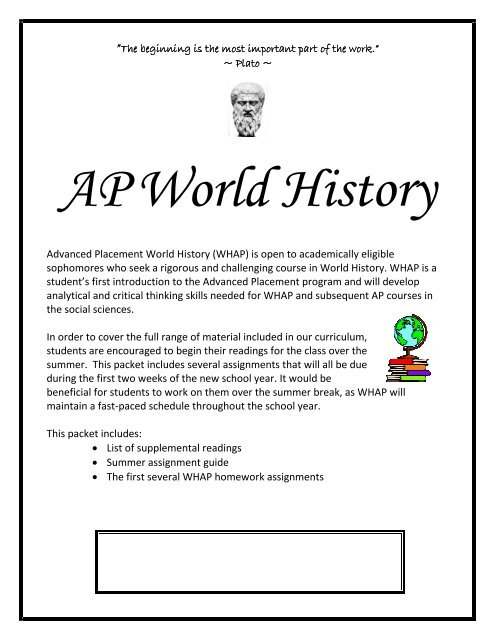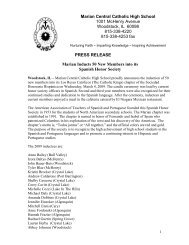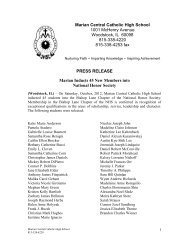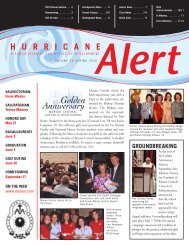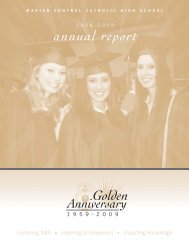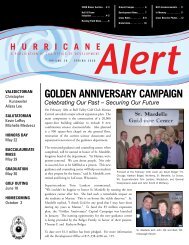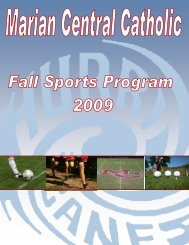WHAP - Marian Central Catholic High School
WHAP - Marian Central Catholic High School
WHAP - Marian Central Catholic High School
You also want an ePaper? Increase the reach of your titles
YUMPU automatically turns print PDFs into web optimized ePapers that Google loves.
”The beginning is the most important part of the work.”<br />
~ Plato ~<br />
AP World History<br />
Advanced Placement World History (<strong>WHAP</strong>) is open to academically eligible<br />
sophomores who seek a rigorous and challenging course in World History. <strong>WHAP</strong> is a<br />
student’s first introduction to the Advanced Placement program and will develop<br />
analytical and critical thinking skills needed for <strong>WHAP</strong> and subsequent AP courses in<br />
the social sciences.<br />
In order to cover the full range of material included in our curriculum,<br />
students are encouraged to begin their readings for the class over the<br />
summer. This packet includes several assignments that will all be due<br />
during the first two weeks of the new school year. It would be<br />
beneficial for students to work on them over the summer break, as <strong>WHAP</strong> will<br />
maintain a fast-paced schedule throughout the school year.<br />
This packet includes:<br />
• List of supplemental readings<br />
• Summer assignment guide<br />
• The first several <strong>WHAP</strong> homework assignments<br />
Learning without thinking is labor lost:<br />
Thinking without learning is perilous.<br />
~Confucius<br />
~
Advanced Placement World History<br />
Supplement Reading Assignment<br />
In addition to the handouts, all <strong>WHAP</strong> students will be responsible for obtaining<br />
the following books to be use throughout the course of the year.<br />
World Civilizations: The Global Experience<br />
By Peter Sterns et al., AP ed. 5 th ed., 2007<br />
(Pearson Longman, ISBN 0-13-220699-4)<br />
A standard student world history textbook<br />
Documents in World History<br />
By Peter Sterns, et al. Vol. I & II, 5 th ed., 2009<br />
Volume I: The Great Traditions, from Ancient Times to 1500<br />
ISBN 0-205-61789-1<br />
Volume II: The Modern Centuries, 1500 to present<br />
ISBN 0-205-61947-9<br />
(Pearson Longman)<br />
This Fleeting World: A Short History of Humanity<br />
By David Christian, 2008 (Berkshire Publishing Group, ISBN 978-1-933782-04-1)<br />
Overview of World History from the global perspective<br />
The History of the World in Six Glasses<br />
By Tom Standage, 2005 (Walker & Co., ISBN 0-802-71447-1)<br />
A look at World History through six beverages<br />
Siddhartha<br />
By Herman Hesse, 1951 (Dover Publications, ISBN 0-486-40653-9)<br />
Historical fiction about Buddhism and search for enlightenment<br />
The Two Hearts of Kwasi Boachi<br />
By Arthur Japin, 2002 (Vintage, ISBN 0-375-71889-3)<br />
Two Ashanti Princes dealing with race in Holland and Java during the 19 th Century<br />
All Quiet on the Western Front<br />
By Erich Maria Remarque, 1929 (various publications)<br />
Novel about life on the Western Front during World War I<br />
A Long Way Gone: Memoirs of a Boy Soldier<br />
By Ishmael Beah, 2007 (0-374-10523-5)<br />
Memoir of a child soldier from Sierra Leone<br />
2
<strong>WHAP</strong> Summer Assignment Guide<br />
The assignments contained in this packet will be due during the first two weeks of the new school<br />
year. The first will be due on the second day of school and subsequent assignments will be due about<br />
every / every other day. It is not necessary that you have all of these completed before the semester<br />
begins, but doing so will make your transition into this class much easier.<br />
Completed assignments may be typed or neatly handwritten on a separate sheet of paper. Answer<br />
all questions in their entirety. Also, clearly label each question number and name of the assignment.<br />
The intent of each assignment is to give you an opportunity to demonstrate your understanding of<br />
the material being considered. As a result the length of your responses may vary greatly. Never<br />
worry about how long an answer is “supposed” to be. It should always be as long as you need it to<br />
be.<br />
You will need to outline Chapter 1 in the textbook. See “How to Outline Properly” below.<br />
You should do the assignments in the following order:<br />
1. HWK #1 - What is World History?<br />
2. HWK #2 - World Map<br />
3. HWK #3 - This Fleeting World by David Christian<br />
4. HWK #4 - Chapter 1 Outline<br />
5. HWK #5 – Documents in World History Vol. I, pg 9-23, answer all Study Questions. You<br />
DO NOT need to complete Essay Suggestions<br />
6. HWK #6 – Beer from A History of the World In 6 Glasses by Standage<br />
If you have any questions regarding the assignments above, please feel free to email me:<br />
apowe@marian.com.<br />
3
How to Outline Properly<br />
The outlining method is perhaps the most common form of note taking used by college students; an<br />
outline naturally organizes the information in a highly structured, logical manner, forming a skeleton<br />
of the textbook chapter or lecture subject that serves as an excellent study guide when preparing for<br />
tests.<br />
In your textbook, the major headings and blue and sub-heading are orange. Use these in your<br />
outline. All bold textbook terms should be highlighted or underlined in your outline and defined.<br />
Most textbook chapters are between 20-30 pages.<br />
1. All outlines must be typed and single spaced.<br />
2. Be sure to not copy directly from the text, but put those thoughts and ideas in your own<br />
words<br />
3. Make sure you are not just listing information, you need to explain it. Every term, person, etc.<br />
should have a short explanation. You may know it now, but you won’t later.<br />
4. Include details like names, dates, etc..<br />
5. Make sure you format correctly. Every “A” needs a “B”, every “1” needs a “2” etc.. (see<br />
sample) Indent each new subgroup.<br />
A. Main Idea<br />
1. Detail<br />
a. Support<br />
b. Secondary Support<br />
i. Specific detail<br />
6. Make sure your margins line up.<br />
7. Do not waste paper by using a font larger than 12. Don’t kill my eyes with anything smaller<br />
than 10.<br />
8. Outline the entire chapter, even the graphs, maps, primary source documents, etc.<br />
9. Anything shorter than 3 pages will not pass; there is no way to cover an entire chapter in that<br />
length. Minimalists will not do well on this activity. However, 10 pages is too many. Don’t<br />
copy the chapter. Read and in our own words outline.<br />
10. Make sure you have sub points. If you never go beyond capital letters ex. A, B, C, .. you will<br />
never have enough detail.<br />
11. Use bold words or highlight key people and terms in the chapter.<br />
Proper Outline Format<br />
Ch # & Title<br />
I. First Main Idea<br />
A. Detail #1<br />
1. Support #1 (related to D#1)<br />
2. Support #2 (related to D#1)<br />
3. Support #3 (related to D#1)<br />
a.) Sub-pt #1<br />
b.) Sub-pt #2<br />
B. Detail #2<br />
1. Support #1 (related to D#2)<br />
2. Support #2 (related to D#2)<br />
4
What is World History?<br />
Read the following quotes about world history and then answer the questions.<br />
William McNeill, Professor Emeritus of History at the University of Chicago<br />
“We don’t study the history of each separate state to understand American history. Nor do we study<br />
the state histories of California, Texas and Alaska and presume that their population and/or<br />
geographic advantage gives us the complete picture. Rather we study national experiences and<br />
developments to understand the history of the US. Similarly, in world history, we do not study the<br />
national histories of the biggest countries or the developments of the largest civilizations. Rather, we<br />
explore the global processes and connections that have shaped the world through time.”<br />
Heidi Roupp, President of the World History Association<br />
“World history is developing as a macrohistory - a history of the human experience [where]<br />
encounters with strangers are the main drive wheel of social change.”<br />
Dr. David Smith, Professor, Cal Poly Tech, Pomona, CA<br />
“World history is more general than traditional history and emphasizes trends that transcend cultural<br />
boundaries. World history stresses the treatment of inter-action between societies. In eras where<br />
such inter-action is limited, it compares different patterns of development around the world. Hence<br />
a world history study may involve cultures that actually had contact and influence on one another or<br />
cultures that went through various stages of development with little or no outside influence. World<br />
history tends to be more superficial and general than local or national histories. This is not meant in a<br />
negative way, but in the sense of a comprehensive view of history. The old cliche of not seeing the<br />
forest for the trees applies here. World history looks at the forest for the overall, global meaning of<br />
history. ”<br />
Marilynn Hitchens, Professor, Univ. of Colorado at Denver<br />
“A world history course should strive not to become a course in great civilizations, a study of various<br />
regions of the world, or a global issues course. What it should be is the study of human change and<br />
continuity over time.”<br />
Geoffrey Barraclough, British Historian and former Chichele Professor of Modern History, University<br />
of Oxford<br />
“World history in its contemporary connotation is not a synthesis of known fact or a juxtaposition of<br />
the histories of different continents or cultures, arranged in some sort of order of relative<br />
importance; rather it is a search for the links and connections across political and cultural frontiers. It<br />
is concerned not so much with development in time or with the goal and meaning of history--<br />
western preoccupations which non-western cultures for the mot part do not share-- as with the<br />
perennial problems which have assailed mankind everywhere and with the different responses to<br />
them. It [world history] has turned them [world historians] away from linear development, from the<br />
thread allegedly running through history from its earliest beginnings to the present day, to the<br />
comparative study of the institutions, habits, ideas and assumptions of men in all times and places.”<br />
5
Dr. David Christian, Professor, San Diego State University, San Diego, CA<br />
“We cannot fully understand the past few millennia without understanding the far longer period of<br />
time in which all members of our own species lived as gatherers and hunters, and without<br />
understanding the changes that led to the emergence of the earliest agrarian communities and the<br />
first urban civilizations. Paleolithic society, in its turn, cannot be fully understood without some idea<br />
of the evolution of our own species over several million years. That however requires some grasp of<br />
the history of life on earth, and so on. [“big history”]<br />
Dr. J. Donald Hughes, Professor, Univ. of Denver, Denver, CO<br />
“The new narrative of world history must have ecological process (instead of development) as its<br />
major theme. It must keep human events within the context where they really happen, and that is<br />
the ecosystem of the earth. The story of human history, if it is to be balanced and accurate, will<br />
inevitably consider the natural environment and the myriad ways in which it has both affected and<br />
been affected by human activities.”<br />
Using complete sentences, answer the following questions on a separate sheet of paper.<br />
1. How important is the idea of connections to the authors above? Explain.<br />
2. What are some examples of global processes? Why do they matter in world history?<br />
3. What creates change in history?<br />
4. Does world history always involve people?<br />
5. Explain the role of the environment in world history?<br />
6. Can world history be local? Explain.<br />
7. What differences of opinion do you see within these definitions?<br />
8. Humans are clearly the primary field of investigation for AP world history. How do historians<br />
communicate human agency as the major vehicle for change (as opposed perhaps to<br />
technological or environmental determinism)?<br />
9. Name one other observation you have after reading these quotes.<br />
10. In your own words, define world history.<br />
6
<strong>WHAP</strong> Summer Map Assignment<br />
Use the maps throughout text to complete the map at the end of the Summer Packet. Neatness<br />
counts so be sure to neatly label the map.<br />
Regions – Shade each region a different color and create an appropriate key. Sections of Africa and<br />
Asia have already been divided into appropriate regions.<br />
• Europe<br />
• East Asia<br />
• Southeast Asia<br />
• South Asia (India)<br />
• Middle East<br />
• Australia<br />
• North Africa<br />
• <strong>Central</strong> Africa<br />
• West Africa<br />
• East Africa<br />
• Southern Africa<br />
• North America<br />
• Latin America and the Caribbean<br />
Oceans<br />
• Atlantic<br />
• Pacific<br />
• Indian<br />
• Southern<br />
• Arctic<br />
7
This Fleeting World: A Short History of Humanity<br />
By David Christian – 2008<br />
Introduction<br />
1. Explain the role and purpose of This Fleeting World, according to Christian.<br />
Beginnings: The Era of Foragers<br />
2. What is the Paleolithic era? Who are “foragers”? Why has the era of foragers typically not been studied by<br />
historians?<br />
3. List the three types of evidence used to study the era. Provide a brief explanation of each.<br />
4. What is Carbon dating? How has this been help to historians and anthropologists?<br />
5. When did human history begin? Explain the two theories of human evolution and migration. What specific<br />
evidence is used by each theory? Which theory do you feel is most plausible? Explain.<br />
6. Explain which factors distinguish humans from other species.<br />
7. Why were population densities low in foraging communities? How were small foraging communities tied<br />
together and organized? How did men and women share the work and power?<br />
8. Why did Australia and the Americas have so many extinctions of large mammals? Why impact did those<br />
extinctions have on the history of these regions?<br />
9. What is “fire-stick farming”? How closely should the development of humans be linked to the environment?<br />
Explain.<br />
10. Why might some people say that foragers were affluent? Do you agree? Explain.<br />
Acceleration: The Agrarian Era<br />
11. How does agriculture differ from foraging? Where and when did agriculture start?<br />
12. Explain how climate change might have contributed to the rise of farming? How might population growth have<br />
caused sedentary lifestyles?<br />
13. Where and why did agriculture spread rapidly?<br />
14. List and explain each of the six characteristics shared by agrarian communities.<br />
15. What is the secondary product revolution? How did it impact humans? How can pottery help prove if the theory<br />
of a “secondary products” revolution is true?<br />
16. How do archaeologists find evidence of institutionalized hierarchies? Explain how men began to dominate<br />
women.<br />
17. What caused cities and states to emerge?<br />
18. What are imperial states? What were the limits on imperial rule? What impact did the rise of large empires have<br />
on Afro-Eurasian political, social, and economic life?<br />
19. What factors cause the rise of religions throughout the world? Which other implications did these factors cause?<br />
8
20. Did the Americas experience expanded political systems in the Agrarian Era? Cite specific evidence to support<br />
your answer.<br />
21. The Vikings, Mongols, and Ming Admiral Cheng Ho are examples of what phenomenon in the era from 1000-<br />
1750? What role did Western European states play in the global networks from 1000-1750?<br />
Our World: The Modern Era<br />
22. When did the “Modern Era” begin?<br />
23. What political, social/gender, economic, and technological changes and continuities occurred in the modern era?<br />
24. How has population growth in the modern era impacted the complexity and role of government?<br />
25. In what ways was innovation in the modern era built on change that started in the Agrarian era? Explain how the<br />
rise of commercial society increased innovation.<br />
26. How did Western Europe fare in the Agrarian and Modern Eras? Thoroughly explain.<br />
27. What were the time periods and characteristics of the three waves of the industrial revolution?<br />
28. What impact did the 19 th century industrialization have on the wealth and power of countries? How did<br />
industrialization change culture?<br />
29. Explain in what ways the 20 th century was a time of rivalry.<br />
30. For each of the following, explain how the event impacted the modern era.<br />
a. World War I<br />
b. The Russian Revolution<br />
c. The Great Depression<br />
d. World War II<br />
31. What changes to global relations and power occurred following World War II?<br />
32. What impact has global consumerism had on the earth?<br />
Periodization in World History<br />
33. What is periodization?<br />
34. What are some of the theoretical, organizational, ethical, and technical problems of periodization in World<br />
History?<br />
35. Why are the periodization labels ancient, medieval, and modern problematic?<br />
9
A History of the World in 6 Glasses<br />
Tom Standage – 2005<br />
Introduction – Vital Fluids<br />
1. List the various uses of different beverages throughout history<br />
2. Standage uses beverages for each major time period. List the six beverages and corresponding the<br />
time period.<br />
Chapter 1 – Beer in Mesopotamia and Egypt<br />
3. Briefly describe the life of early humans. How important were grains in daily life?<br />
4. Explain the two important discoveries made about cereal grains.<br />
5. How are wine and mead created? What advantages did beer have over these two beverages?<br />
6. What is bappir? How did Mesopotamians use bappir? What came first the beer or the bread?<br />
7. Explain the social significance of drinks in Sumerian culture.<br />
8. Who is Osiris? How did he accidently discover beer? Explain the various ritual uses of beer in the<br />
Americas, Africa, and Eurasia.<br />
9. Explain the two theories surrounding the shift from hunting and gathering to agriculture.<br />
10. Explain Standage’s point of view on the role of beer in the transition to agriculture?<br />
11. Why was beer often a better choice than water for humans? How did beer aid in the declining food<br />
quality?<br />
12. Explain the role of the communal storage house. How were ancient societies affected by having a<br />
surplus?<br />
Chapter 2 – Civilized Beer<br />
13. Explain the factors why people chose to live in large cities.<br />
14. Define civilization. Explain the reason for civilizations in both Egypt and Mesopotamia.<br />
15. Explain the role of beer and bread in the Epic of Gilgamesh. Why is beer such an important beverage to<br />
Mesopotamians and Egyptians?<br />
16. How did writing develop in Sumer? How was writing related to compulsory taxes used by the priestly<br />
class?<br />
17. In what ways was beer used as currency in Mesopotamia? Egypt?<br />
18. Explain the medical purposes of beer as used by Egyptians and Mesopotamians.<br />
10


